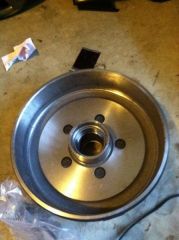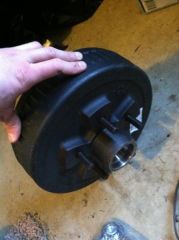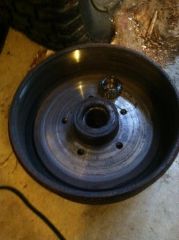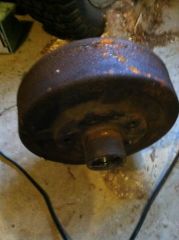-
Posts
586 -
Joined
-
Last visited
Content Type
Profiles
Forums
Articles
Gallery
Downloads
Events
Everything posted by ThorsHammer82
-

Improvised Anvil - Worth It?
ThorsHammer82 replied to Blackcat's topic in Anvils, Swage Blocks, and Mandrels
any self respecting smith would be happy to have that to hit on. I would stand it with the tall side vertical if it were mine. -

Adding weight to a post anvil
ThorsHammer82 replied to navasky's topic in Anvils, Swage Blocks, and Mandrels
The concrete will eventually (quicker than you'd think) break down and be useless. You're better off using a metal or wood stand. -
randomly scrolling through the interwebs today hit this thread on the head when I found this little gem. It has been empirically proven in 1999, by psychologists David Dunning and Justin Kruger in their report "Unskilled and Unaware of It: How Difficulties in Recognizing One's Own Incompetence Lead to Inflated Self-Assessments".
-
Dave, Part of the reason your hammer shakes the shop so bad is because of the concrete floor. It transfers vibration far better than gravel or soild does. I think in his situation it's really going to depend on how far from his hammer he wants to build his forge.
-

New chimney, downdraft or poor draw
ThorsHammer82 replied to Nick's topic in Chimneys, Hoods, and Stacks
yeah, we've had some pretty crazy fires in that beast at times. but usually when we're cranking it to warm the place up when no one's been there for a week+ is when the fire is the biggest. But the fire is going pretty much full bore for 2-3 days straight on average if not longer even in the summer. so the heat has plenty of time to work it's way up the chimney. -
you should be able to find bolts that aren't "plated" at any hardware store. or automotive store.
- 7 replies
-
- galvanized
- zinc
-
(and 1 more)
Tagged with:
-

Show me what YOU found !!
ThorsHammer82 replied to Glenn's topic in Blacksmithing, General Discussion
when I picked up my coal from the supplier their truck scale was an old school manual balance scale. I took a picture at the time but must have deleted it. I was pretty impress. The guy said they get it certified every 6 month's or so. and usually doesn't need any adjustment to get it accurate. -

New chimney, downdraft or poor draw
ThorsHammer82 replied to Nick's topic in Chimneys, Hoods, and Stacks
I assume you're referencing the size of the chimney in the cabin, and to that I just point out the usefulness of a damper. -
next time try to scrounge a Y Pipe for the Twyere. than you just need to drill the hole for your retainer pin/grate.
-

New chimney, downdraft or poor draw
ThorsHammer82 replied to Nick's topic in Chimneys, Hoods, and Stacks
The fire place in my family's cabin has a metal chimnet that is 18"x24". It goes through the second floor before exiting the roof some 20+' total length and even the high temp paint peels on that on a regular basis. We can get the cabin cooking though. 80+ degrees when it's sub freezing outside. and it's a log cabin that was built in the EARLY 1900's. we did a repair on the addition and found news papers that were used as insulation announcing that Lindberg had crossed the Atlantic. yes I understand thatthe size of a forge fire is drastically smaller than the 3'x5' fire place at the cabin but it's still a concern that should be mentioned. -

New chimney, downdraft or poor draw
ThorsHammer82 replied to Nick's topic in Chimneys, Hoods, and Stacks
I'd give the turbine top from stuart's thread a try. unless it's high temp paint you run the risk of it just peeling off once you get the chimney hot. -

Flexible handles on tools
ThorsHammer82 replied to Glenn's topic in Blacksmithing, General Discussion
what no one else pointed out was the lack of effort he was putting into his swings. My dad works in the timber industry and I've grown up around logging my entire life. I watched professional loggers use axes and I've used more than a fiew my self. that guy looked like he was swatting at flies not chopping down a tree. He wasn't even breaking a sweat. my observation is that his technique and his tools are a completely different mindset than say an american lumber jack. Here, we take a large axe head with good mass and put that on a stiff handle than we swing it as hard as we can at a tree to force the axe head as deep into the wood with each stroke as we can. I would argue that he put less effort, and far less energy burned into cutting down that tree than I would using a "proper" US style axe. I agree his axe probably could have been much sharper. Also, not knowing where the video was taken, but understanding that most jungle trees tend to be hardwood (mahogany, ironwood, ect) vs soft like a fir/pine tree It's hard to say how hard the tree was to cut. I think the best comparison for this would be a graphite handled golf club. The flex is closer and the entire set up is closer than the example of a fishing pole. The shaft is flexible to increase the force that the head imparts on the item it's striking. -
but wait, if you're one of the first 25 callers we'll throw in a second set free (just pay shipping and handling) I think the draw of the brake drum forge is it has the look of what people think of when they think of a forge. Most people don't see built in forges. they see travel forges that are small and simple. They have a fire in a bowl and something to blow air into it. the brake drum forge works for that. where as a side draft just doesn't fit the picture and the bucket forge just seems to simple it can't be true. and when it comes down to it, it's just complicated enough to make people think which is really what they are looking for because someone who can form and shape metal has to be smarter than they are. You don't want to think that the person fixing your plumbing, or doing your electrical is dumber than you because they "know what they are doing". It's the fear of failure that keeps most people from doing something themselves. Once they realize that the people who built this country were no smarter than they are a whole new world opens up to them. The only difference between someone who knows what they are doing and someone who doesn't is practice.
-

What to use for a 12" chimney?
ThorsHammer82 replied to rwolfe's topic in Chimneys, Hoods, and Stacks
thats because most wood stoves use 6" or 8" at most for their chimneys. have you talked to your local fireplace supply store? seen what they say you'll need for the pass through? -
what's the floor? soil? gravel? concrete?
-
this was taken from the interwebs, but you can see how there is still a slight gap where the original bolt holes were and the edge of the flange, but those will clog up pretty quick with ash and what not and wouldn't effect the forge if they didn't fill up. but it's a great photo of the assembly of a fully thread together/bolt together minimal tools required brake drum forge.
-
The "pilot" or "lip" in my 3500lb trailer brake drums are much larger than the mobile home drum as you can see in my pictures above. I'll have to measure when I get home.
-
if you're using a flange to attach the twere to the bottom of the drum with bolts the holes are coverd by the flange, or easily filled with a bolt.
-
thats what I'm saying. my brake drum didn't require any drilling, at least it wouldn't have if I'd gone that route. It had the center hole open already. it was from the rear axle of an 86 chevy s-10 pick up. lets face it, unless you're really good at scrounging, have a decent tool selection and plenty of scrap (my case), or are given you're equipment. You're going to have to spend some money. It was cheaper for me to use scrap and the tools and equipment on hand than to do a threaded pipe twere, but if I didn't have that stuff $50 in pipe fittings isn't all that bad. and a good days worth of manual labor should net you that much at least as a teen these days. I was making $10 an hour for manual labor in my teens. Thats why I can't afford to pay a neighbor boy to do my work for me now. but I'm getting off the point. a little bit of money and common tools can get you a working forge for around $50. and even with the electric brake drums you're still going to have to put money into a twere or you're going to have problems with ash in you ducting. so why not use a regular brake drum that already has the center out of it and gives you a deeper fire pot. I mean if thats all you've got it will work, but so will a brake rotor if thats all you've got. Maybe I'm just working on the wrong vehicles/equipment, but I can't recall ever seeing a brake drum that didn't have a hole in the center. so what's wrong with drilling a few holes? how many people do you know who don't have access to a power drill?
-
I used a regular automotive brake drum. It was far easier to use and no need to wait for hollow below the "pilot" to fill up. I was just trying to illistrate why I think a brake drum for a hydrolic system would be a better choice than a drum from an electric brake system. Especially for someone with minimal tools and fabrication abilities, let alone funds.
-
I'm not sure how I could have the wrong one... as all the electric brake trailer brake drums I've ever come in contact with have all had that. They have to have it to hold the drum on the spindle and bearings. unlike a traditional truck axle where there is an axle shaft that spins inside a housing, the trailer axle doesn't spin and the drum spins around the spindle. because the "puck" as you called it, rides on the rotating face of the drum they can't have a separate hub to mount the drum on like you'd find in a none drive axle on a car. on on a hydrolic trailer axle. but those drums wouldn't have the thicker machined face that an electric brake drum would have. theses are examples of the older style trailer brake drums that use electric brakes and lug bolts instead of lug nuts. http://www.iforgeiron.com/gallery/image/37721-hub/ http://www.iforgeiron.com/gallery/image/37722-hub2/ These are examples of the newer style trailer brake drums that use wheel studs and lug nuts. http://www.iforgeiron.com/gallery/image/37723-hub3/ http://www.iforgeiron.com/gallery/image/37724-hub4/ As you can see both have the "pilot" for the bearings and do not have a flat bottom like an automotive brake drum would have. now, you could cut out the "pilot", but without the right tools you'd have more time and effort trying to do that than you would just using an automotive/hydrolic brake drum. the hydrolic brake drum forges can be built by bolting a pipe flange onto the bottom of the drum, and don't require the use of any special tools. Just a drill and some wrenches.
-
-




